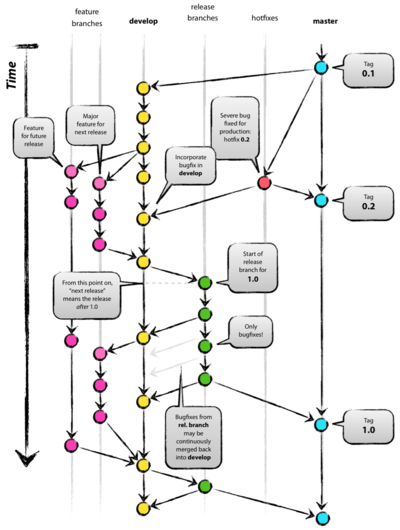git-flow源于2010年一篇A successful Git branching model的文章[1],在这10年间被很多团队采用并成为了一个事实上的“标准做法”。[2]
主分支
在这种模型下,git仓库中有两个分支是一直存在的:
We consider origin/master to be the main branch where the source code of HEAD always reflects a production-ready state.
We consider origin/develop to be the main branch where the source code of HEAD always reflects a state with the latest delivered development changes for the next release.
- origin/master(或者main):这个分支上的最新代码永远是production-ready的
- origin/develop:这个分支上的代码永远是下一个发布的最新的交付代码()。也可以称为“集成分支”,用于进行每日构建(nightly builds)
Therefore, each time when changes are merged back into master, this is a new production release by definition. We tend to be very strict at this, so that theoretically, we could use a Git hook script to automatically build and roll-out our software to our production servers everytime there was a commit on master.
当develop分支上的代码达到了上线的标准之后,这些改动就会merge回master分支,并打上release版本号的标签。合并代码到master也就意味着新的产品发布,可以使用web hook来自动进行发布过程:每当master分支有commit的时候自动进行编译、发布等操作发布到生产环境。
辅助分支
feature分支
release分支
hotfix分支
- ↑ https://nvie.com/posts/a-successful-git-branching-model/
- ↑ 作者自己在2020年做了补充说明,认为10年来发生了一些变化,使用Git开发已经成为潮流且更多的应用在向Web APP方向发展。Web应用跟其他的项目有一个比较大的区别就是:Web应用通常持续集成,有问题通常会直接修复了发布而不会回退,不需要同时支持多个版本。这种情况下,作者建议使用更简单的方式如GitHub-flow代替。但同时,作者认为git-flow仍然很好的适用于以下的场景:构建多版本应用(或者说需要同时支持不同的版本)
